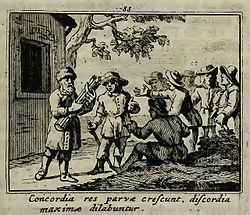The Old Man and his Sons

The Old Man and his Sons, sometimes alternatively titled The Bundle of Sticks, is one of Aesop's Fables and is numbered 53 in the Perry Index. The actions described in it have been attributed to several later rulers and its political moral that there is strength in unity has been consistently commented on over the centuries.
The Fable
A father has a number of sons who constantly quarrel with each other. As he nears death he calls them to him and gives them an object lesson in the need for unity. Having bound a bundle of sticks together (or in other accounts either spears or arrows), he asks his sons to break them. When they fail, he undoes the bundle and either breaks each stick singly or gets his sons to do so. In the same way, he teaches them, though each can be overcome alone, they are invincible combined.
The fable was included by Babrius in his collection. Later still the story was told of King Scilurus of Scythia and his 80 sons in Sayings of kings and commanders by Pseudo-Plutarch[1] and of other barbarian kings by other authors. The story also travelled eastwards. It may appear in mediaeval Turkic manuscript fragments and on a Sogdian mural.[2] Having entered Central Asian folklore, the story was also told of local chieftains and associated with Genghis Khan.[3]
Later history and interpretations
The moral drawn from the fable by Babrius was that "Brotherly love is the greatest good in life and often lifts the humble higher". When the Neo-Latin poet Hieronymus Osius included it in his 1564 collection, he added consideration of the effects of disunion: "Just as concord supplies potency in human affairs, so a quarrelsome life deprives people of their strength."[4] The French fabulist La Fontaine also stressed this aspect. In this version, the sons had not started quarreling when their father gave them his lesson, but descended into litigiousness over his estate following his death.[5]
That the lesson of the fable could be applied to statecraft as well as personal affairs had earlier been realised by Pseudo-Plutarch and those others who told the story of ancient rulers. In more modern times, Pieter de la Court commented on its applicability to the Dutch Republic in his retelling of the story in Sinryke Fabulen (Amsterdam, 1685) as "A farmer and his seven quarrelsome sons".[6] The story is prefaced with the proverb Eendragt maakt magt, een twist verkwist (Unity makes strength, strife wastes). The first part of this was eventually to be taken as national motto by a number of states in a variety of languages without necessarily referring to the fable. It was also associated with the fasces of the Roman republic, which consists of a bundle of rods, sometimes (but not always) enclosing an axe, symbolising the state's power to rule. However, the moral "Strength lies in union" was certainly given to the fable in, among others, Edward Garrett’s new edition of Aesop's fables in the 19th century.[7]
The political motto "Unity is strength" was definitely associated with the fable by the trade union organisations that adopted it. A depiction of a man kneeling over a bundle of sticks on the ground was used, often accompanied by the motto on, for example, the badge of the Nottinghamshire Miners Association, on a Durham trade union banner, and on a trade token of the Worcestershire Co-operative Society.[8] Some of these show a man crouched with one knee on a bundle of sticks, straining to break them, in a pose that appears related to John Tenniel's picture of the scene in the edition of Aesop's fables that he illustrated.[9] The fable was also referred to by American trade union organisations in the 20th century,[10] and it was among those chosen in 1970 by the activist Jacob Lawrence for illustration in gouaches which draw out the story's moral truth.[11]
Earlier the fable was retold in a long poem that made no reference to Aesop but was represented as happening in England. This first appeared as a 1795 illustrated broadsheet published in London and Bath with the title “The old man, his children, and the bundle of sticks”. There “A good old man, no matter where, Whether in York or Lancashire,” gives the lesson on his deathbed and the poem concludes with a Christian reflection.[12] Over the following decades of the 19th century, it also appeared as a cheaply printed chapbook and in book-length collections of moralising works.[13]
References
- ↑ p.174
- ↑ Vitterhetsakad.se
- ↑ "The Sons and the Spears", click on folklore
- ↑ Fable 53
- ↑ Fables IV.18
- ↑ Een Boer ende seeven twistende Soonen, pp.599-608
- ↑ Published in London, 1867, pp.83-4
- ↑ Mining memorabilia
- ↑ Laura Gibbs at Flickr
- ↑ Archie Green, Calf's Head & Union Tale: Labor Yarns at Work and Play, University of Illinois, 1996, pp.251-3
- ↑ Smithsonian Institution
- ↑ Lewis Walpole Library, Yale University
- ↑ Google Books
External Links
Book illustrations from the 16th-19th centuries